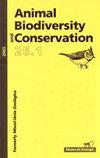Evaluación de un protocolo automatizado para la obtención de medidas morfométricas de huevos de aves a partir de fotografías digitales
IF 1
4区 环境科学与生态学
Q3 BIODIVERSITY CONSERVATION
引用次数: 0
Abstract
Evaluation of a protocol for automated extraction of morphometric measurements from avian eggs using digital photography As many ecomorphological studies are limited by the time required to gather manual measurement data, automatizing the process is an important focus of methodological innovations. We developed, implemented and validated a protocol for the semi–automated extraction of a set of morphometric variables of egg size and shape from digital pictures. The protocol was implemented in R language as a web app called OvometriK. After binarizing and calibrating images, this protocol uses geometric and trigonometric functions to calculate eleven egg variables. We tested calculations in several ways, assuming contour continuity or using voxel counts. Application was validated with geometric shapes and 30 manually–measured chicken eggs. Mathematical validation with spheres showed that the algorithm provided high precision diameter measures, with a correlation of 99.9 %. Average estimation error was 1.4 %. The mathematical volume estimation was underestimated by 27 %, while voxels were underestimated by only 6 %. Differences between manual egg measurements of diameters and those obtained from images was less than 3 mm (4 %). Correlation between estimated volume and measured by silica gel filling was higher than 90 % using the voxel count method. Neither inclination angle or picture resolution had significant effects on precision (3.2 % maximum difference). Measures showed high repeatability and represent a significant saving in processing time. This new protocol represents an improvement on previous programs regarding limitations of platform, accessibility and number of variables. Furthermore, its flexibility and openness means it can be adapted to other specific applications.从数字照片中获得禽蛋形态测量的自动化协议的评估
评估使用数字摄影从禽蛋中自动提取形态测量数据的方案由于许多生态形态研究受到收集手动测量数据所需时间的限制,自动化过程是方法创新的一个重要重点。我们开发、实施并验证了一种协议,用于从数字图片中半自动提取一组鸡蛋大小和形状的形态计量变量。该协议是用R语言作为一个名为OvometriK的网络应用程序实现的。在对图像进行二值化和校准后,该协议使用几何和三角函数来计算11个鸡蛋变量。我们以几种方式测试了计算,假设轮廓连续性或使用体素计数。应用程序通过几何形状和30个手动测量的鸡蛋进行了验证。球体的数学验证表明,该算法提供了高精度的直径测量,相关性为99.9 %. 平均估计误差为1.4 %. 数学体积估计被低估了27 %, 而体素只被低估了6 %. 人工测量卵子直径与从图像中获得的直径之间的差异小于3毫米(4 %). 估计体积与通过硅胶填充测量的体积之间的相关性高于90 % 使用体素计数方法。倾角或图片分辨率对精度都没有显著影响(3.2 % 最大差值)。测量结果显示出很高的重复性,并显著节省了处理时间。这个新协议在平台、可访问性和变量数量方面对以前的程序进行了改进。此外,它的灵活性和开放性意味着它可以适应其他特定的应用。
本文章由计算机程序翻译,如有差异,请以英文原文为准。
求助全文
约1分钟内获得全文
求助全文
来源期刊

Animal Biodiversity and Conservation
农林科学-动物学
CiteScore
2.00
自引率
0.00%
发文量
21
审稿时长
>12 weeks
期刊介绍:
Animal Biodiversity and Conservation (antes Miscel·lània Zoològica) es una revista interdisciplinar, publicada desde 1958 por el Museu de Ciències Naturals de Barcelona. Incluye artículos de investigación empírica y teórica en todas las áreas de la zoología (sistemática, taxonomía, morfología, biogeografía, ecología, etología, fisiología y genética) procedentes de todas las regiones del mundo. La revista presta especial interés a los estudios que planteen un problema nuevo o introduzcan un tema nuevo, con hipòtesis y prediccions claras, y a los trabajos que de una manera u otra tengan relevancia en la biología de la conservación. No se publicaran artículos puramente descriptivos, o artículos faunísticos o corológicos en los que se describa la distribución en el espacio o en el tiempo de los organismes zoológicos.
 求助内容:
求助内容: 应助结果提醒方式:
应助结果提醒方式:


